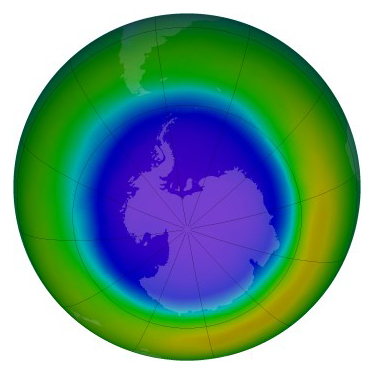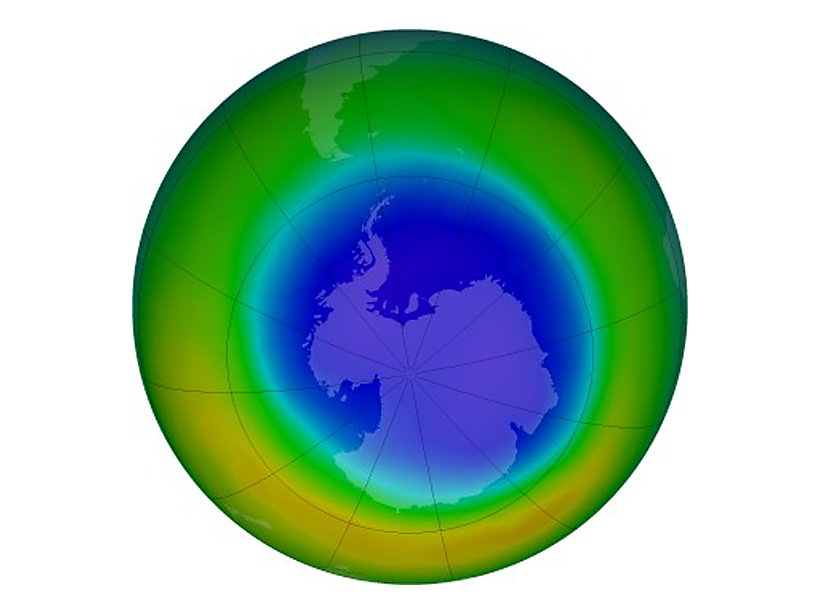
First discovered in the 1980s, the hole in the Earth’s ozone layer that stretches above Antarctica every October is an iconic example of how human activity and atmospheric chemistry are inextricably linked. This hole covered an average of about 18 million square kilometers in September 1987 and widened to nearly 25 million square kilometers in September 2000, thanks to industrial pollutants that destroy ozone in the stratosphere.
The ozone layer protects Earth’s surface and the plants and animals that live on it from ultraviolet radiation from the Sun. Now, scientists report that public policy efforts that banned ozone-destroying chemicals have paid off: The ozone hole has shrunk by more than 4 million square kilometers since 2000. That’s a 16% percent decrease.
“We can now be confident that the things we’ve done have put the planet on a path to heal,” said Susan Solomon, lead author on a Science paper published today and an atmospheric chemist at the Massachusetts Institute of Technology.
Ozone-Destroying Chemistry
In 1986, scientists discovered that CFCs reduced stratospheric ozone concentrations all over the world.
The ozone layer, found 20–30 kilometers above Earth’s surface at the lower edge of the stratosphere, protects the planet from the Sun’s ultraviolet radiation. At the time of the hole’s discovery, industrial activities around the world emitted chemicals called chlorofluorocarbons (CFCs) into the atmosphere.
Thanks to the pioneering research of Solomon and her team in 1986, scientists discovered that CFCs reduced stratospheric ozone concentrations all over the world. At that time, industries used CFCs in refrigeration and dry cleaning; even spritzing hairspray released the chemicals. The reduction was particularly bad over Antarctica, where extremely low concentrations thinned the ozone layer enough that scientists referred to it as the “ozone hole.”
CFCs destroy ozone every Antarctic spring, but the process starts before winter even begins. When the Sun permanently sets in March, a vortex of cold polar wind swirls around the continent, cooling the stratosphere. Water vapor droplets collect around molecules of CFCs, forming clouds.
Once the Sun rises again in July, ultraviolet (UV) light strikes the CFCs, breaking chemical bonds and freeing chlorine. The free chlorine atoms subsequently strip oxygen from ozone molecules (O3) to form other chemicals, destroying the ozone itself. The ozone hole reaches its peak size in October, and by November, the stratosphere heats up enough to break apart this polar vortex fill the hole.
Protecting Stratospheric Ozone
To scientists, the vast hole in the ozone layer over the Antarctic set off warning bells because the ozone layer absorbs ultraviolet radiation from the Sun. Without the ozone layer’s protection, humans and other life would be exposed to the harshest ultraviolet rays, which can burn tissue and trigger mutations in DNA that cause cancer. Put another way, without the ozone layer’s protection, life as we know it would not exist.
Once researchers, including Susan Solomon’s team, found a link between the ozone hole and industrial CFCs, world leaders came together and signed the Montreal Protocol in 1987, which called for a ban on those and similar substances. Production and consumption of CFCs ended in developed countries in 1996 and developing countries in 2010.
The ban had an observable effect on the atmosphere: A National Oceanic and Atmospheric Administration report from 2010 stated that chlorine in the atmosphere from CFCs had declined by 1.3% percent since its peak in 2000.
Examining the Hole
NASA satellites have tracked ozone concentrations since the 1970s, so researchers involved with the new study tapped that database to investigate changes in the ozone layer each September since the year 2000. They also looked at direct measurements taken by scientific balloons that carry instruments into the stratosphere. Between 2000 and 2015, the researchers found that not only is the rate of ozone depletion decreasing, but the size of the annual hole has also shrunk.

Although the hole reaches its maximum size in October, the researchers specifically looked at September because at that point, the swirling polar vortex is more stable, Doug Kinnison, a coauthor on the paper and an atmospheric scientist at the National Center for Atmospheric Research in Boulder, told Eos. In October, the highly dynamic vortex is prone to shifts that can change the size and location of the hole in inconsistent ways, Kinnison said, so by focusing on September, the researchers teased out a stronger signal of changes in size and depletion rate year by year.
Volcanic Interruptions
Sulfur aerosols provide a surface on which ozone-destroying chemical reactions happen.
The researchers hit a snag in the data for 2015: Curiously, the ozone hole reached a record-breaking size that year, a whopping 25.3 million square kilometers, prompting some scientists to rethink their previous estimates of its rate of healing. But Kinnison and his colleagues discovered that the eruption of Chilean volcano Calbuco in May of that year was to blame for the drastic drop in ozone.
The researchers confirmed this by running models of ozone depletion with and without the input of gases from volcanic eruptions. Large volcanic eruptions spew hundreds of thousands of tons of sulfur dioxide into the atmosphere, which reacts with water vapor to form sulfate aerosols. Along with slightly cooling the planet, these sulfur aerosols provide a surface on which ozone-destroying chemical reactions happen. This phenomenon was well documented after every major volcanic eruption, including those of Mount Pinatubo in 1991 and Mexico’s El Chichón in 1982.
Therefore, although the researchers continued to observe a drop in atmospheric chlorine in their models, Calbuco’s 400,000 tons of sulfur dioxide led to an increase in polar stratospheric clouds and thus ozone destruction.
Ozone of the Future
“It’s good to see some sign of improvement,” Susan Strahan, an atmospheric scientist at NASA Goddard Space Flight Center in Greenbelt, Md., told Eos. Strahan wasn’t involved in the research.
“Now we’ve actually seen the planet starting to get better.”
But because of how much temperature can affect the size of the ozone hole year by year, Strahan says it has often been difficult to pick out a signal of healing from the noise.
“We atmospheric scientists are anxiously awaiting the day when we can conclusively look at the observations of the ozone hole and say, yup, it’s definitely getting smaller and, yup, it’s because of chlorine [decrease].” The paper’s results are “a small piece of the puzzle, and we expect that in years to come we’ll see stronger evidence.”
In 2009 scientists at NASA created a vision of a world without the Montreal Protocol. In their “World Avoided” simulation, the researchers predicted that by the year 2065, the ozone hole would not only have stuck around all year, but a twin would have formed over the North Pole. In that scenario, people in midlatitude cities would suffer sunburns after 5 minutes outside, and DNA-mutating radiation would increase 500%.
Instead, Solomon expects that the ozone hole will shrink and eventually seal up by midcentury.
Science was helpful in charting a path away from these molecules for countries to follow, Solomon explained. “Now we’ve actually seen the planet starting to get better,” she said. “It’s a wonderful thing.”
—JoAnna Wendel, Staff Writer
Correction, 1 July 2016: An earlier version of this article gave an incorrect affiliation for the National Center for Atmospheric Research. This has been fixed.
Citation:
Wendel, J. (2016), Antarctica’s ozone hole is healing, scientists say, Eos, 97, https://doi.org/10.1029/2016EO055309. Published on 30 June 2016.
Text © 2016. The authors. CC BY-NC-ND 3.0
Except where otherwise noted, images are subject to copyright. Any reuse without express permission from the copyright owner is prohibited.

